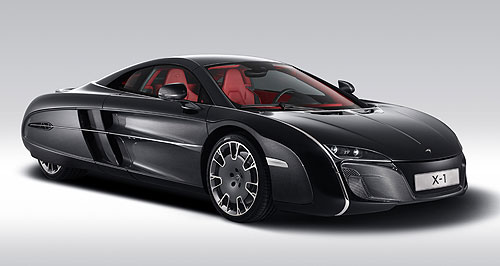Future models - McLaren - X-1One-off McLaren X-1 unveiled at Pebble BeachOne in a million: The 12C-based, one-off McLaren X-1 supercar underwent rigorous testing to make sure it is road legal and just as capable as the donor car. McLaren’s bespoke service builds outlandish 12C-based X1 for mystery enthusiast20 Aug 2012 McLAREN Automotive unveiled an outlandish one-off version of its 12C supercar at the Pebble Beach automotive event in California over the weekend. Called X-1 but bearing no resemblance to a BMW compact SUV, the road-legal and fully developed show-stealer was commissioned by a mystery McLaren enthusiast and showcases the level of customisation available from the McLaren Special Operations (MSO) bespoke service launched a year ago. The client, who has also owned a McLaren F1, Mercedes-Benz SLR McLaren and 12C, wanted designers from inside and outside McLaren – including some from outside the automotive industry – to submit competing ideas. Inspiration for the design – made up of carbon-fibre panels and solid aluminium brightwork – was taken from cars, architecture, fashion, movies and even food. The client finally settled on the flowing retro-futuristic, art-deco lines seen here, penned by McLaren’s Hong Yeo – a Korean-born graduate of the Royal College of Art in London. Among the vehicles submitted by the client as inspiration were a 1961 Facel Vega, a 1953 Chrysler D’Elegance Ghia, a 1959 Buick Electra, a 1939 Mercedes-Benz 540K and a 1971 Citroen SM. From the world of architecture were the Guggenheim museums in New York and Bilbao, Spain, while further inspiration came from a Jaeger LeCoultre art deco clock, an Airstream caravan, a Thomas Mann Montblanc pen and a photo of Audrey Hepburn. The food connection came in the shape of an eggplant, which was joined by a grand piano as examples of shiny finishes favoured by the client, according to McLaren design director Frank Stephenson. MSO program director Paul MacKenzie said the client approached the company’s executive director Ron Dennis almost three years ago, while the 12C was still in development. “The client wanted a machine that had all the capability of the 12C but wrapped in a unique body that reflected his needs and personality.” Mr McKenzie then met with the client, who described the brief as creating a car with “timeless and classical elegance”. One of the challenges facing Mr Yeo was that the cars from which the client drew inspiration were of a traditional front-engine, rear-drive layout whereas the 12-C has its twin-turbo V8 located behind the cockpit. McLaren says finding the right visual balance required “months of sketching and modelling”, with the final design taking 18 months to sign off and the client demanding to see 30 per cent scale and full-size foam models instead of the digital representations originally planned. Despite the X-1’s styling being far removed from usual McLaren fare, with only the glasshouse carried over from the 12C donor car, Mr Yeo said it “embodies the McLaren value that every part has to have a purpose”. “No details are simply visual cues every one has a purpose … although I like to think the wide body combined with pontoon-style rear fenders will ensure the car glides when it’s moving just like a superhero’s cape.” Mr Yeo was pointing to the enclosed rear wheels, which are accessed by raising carbon-fibre panels supported by what Mr Stephenson described as “some of the most gorgeous hinges you’ve ever seen”, with the open panels adding an almost Batmobile-esque presence. As a result of the exterior modifications, the X-1 is 109mm longer and 188mm wider than the 12C, but due to the extensive use of carbon-fibre panels, attached to the 12C’s unique carbon-fibre ‘MonoCell’ tub chassis, it weighs around the same at roughly 1400kg. The panels are painted in piano black with no metallic or colour tints, which Mr Stephenson said made it “one of the most challenging colours to paint”. Because the X-1 was to be a road-legal vehicle with a brief to be just as capable as the 12C on which it is based, McLaren gave the car its own development program. This included an aerodynamics program to ensure high-speed stability and more than 1000 kilometres of testing, including two stints at the Spanish Idiada circuit with McLaren test driver Chris Goodwin at the wheel. McLaren claims the MonoCell chassis enabled the car to maintain the 12C’s “engineering purity” while adopting a vastly different exterior look. After testing, the X-1 was rebuilt by hand to “concours standard” ready for its Pebble Beach debut. Given the amount of work done on the car’s exterior styling, the interior is surprisingly standard, adding bespoke ‘Harissa Red’ Nappa leather upholstery, upgraded carpets, machined nickel-coated switchgear and titanium weave for the carbon trim panels, said to provide a “magical 3D-like effect”. Mr Stephenson described the X-1 project as “a truly rewarding and unforgettable experience”. “I think that we as a team have created a completely unforgettable car that is true to one man’s vision.” MSO originally expected 10 per cent of 12C buyers to use the personalisation service but is experiencing demand at 15 per cent and rising – and by the end of this year, 20 per cent of 12C customers are expected to ask for “some degree of personalisation”. “There is a major trend to individualise premium cars, and we expect the demand to continue to rise,” said Mr MacKenzie.  Read more16th of August 2012  Most potent McLaren 12C revealedMcLaren harks back to past glories with hardcore MP4-12C Can-Am concept4th of July 2012  McLaren 12C Spider roars inFormula One team McLaren’s supercar branch spawns sleek 329km/h 12C roadster2nd of July 2012  McLaren to build a convertibleBritish supercar-maker McLaren announces its second model will be a Spider |
Click to shareMcLaren modelsResearch McLaren Motor industry news |






































Facebook Twitter Instagram